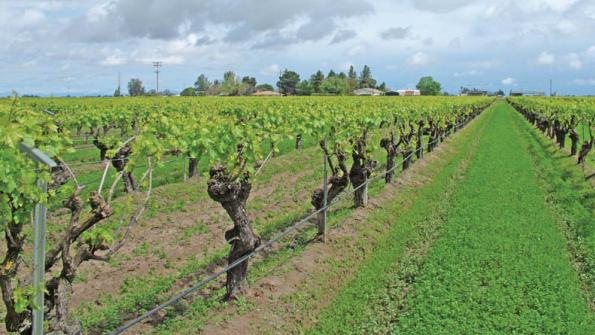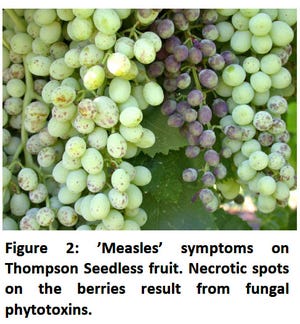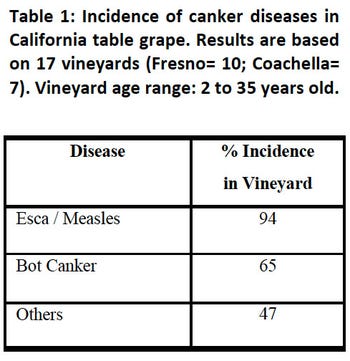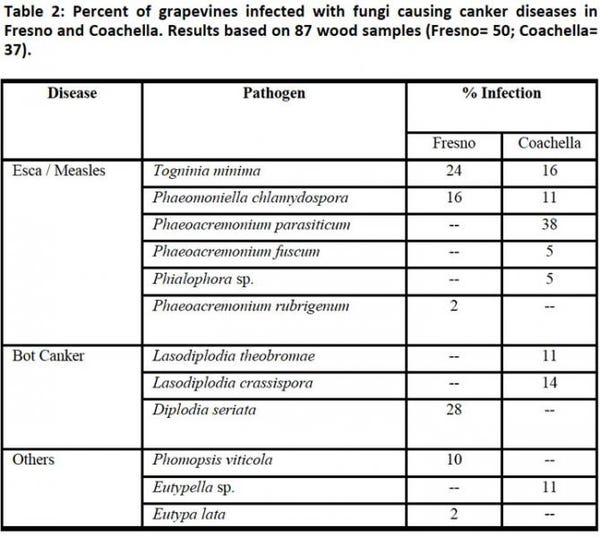
The loss in revenues is significantly measurable when vineyards turn 10 years old and canker diseases worsen each year reducing yields.Canker diseases are known to be responsible for a significant decrease in vineyard longevity and productivity and an overall reduction of profits. However, their economic impact in California’s table grape vineyards has not yet been fully measured.
December 5, 2011

Canker diseases are known to be responsible for a significant decrease in vineyard longevity and productivity and an overall reduction of profits. However, their economic impact in California’s table grape vineyards has not yet been fully measured.
Canker diseases (e.g., measles, bot canker, eutypa dieback) are caused by a complex of fungal pathogens that infect grapevines soon after a vineyard is planted. However, it usually takes several years for the first symptoms to appear. As a vineyard ages and the disease becomes more severe, growers encounter a decrease in yield due to the collapse of fruit bearing spur positions, the dieback of cordons, and eventually the decline of the entire grapevine.
The loss in revenues is significantly measurable when vineyards turn 10 years old and canker diseases worsen each year reducing yields. Siebert (2001) evaluated this loss at 16 percent of the annual gross producer revenue in wine grape production (Fig.1), a figure that is comparable in table grape production. Conversely, table grape growers must also account for a loss in fruit marketability.

Grapevines infected with ‘measles’ (a.k.a. Esca) often have blemished berries (Fig.2). Vasquez et al. (2007) reported that severity of ‘measles’ on fruit at harvest ranged from 35 percent to 55 percent in 25-30 year old Thompson seedless vineyards.
The fungi that cause ‘measles’ reside in wood vessels within the grapevine spurs, cordons or trunks and produce phytotoxins that are translocated to the fruits causing
the appearance of necrotic spots on the skin. Another obvious symptom specific to ’measles’ is the development of tiger-striped leaves (Fig.3) also resulting from fungal phytotoxins. The expression of the disease and its direct consequence on revenue losses fluctuates from year to year and is unfortunately not predictable.
For example, in 2011, phone calls from San Joaquin Valley table grape growers regarding symptoms of measles impacting their crop were up 50 percent when compared to 2010.
Current research points to the increase of measles symptoms resulting from high winter and spring rains, which was characteristic of 2011.
Over the past two years, we conducted a survey to evaluate the presence of canker producing pathogens in California’s table grape production areas. Our survey conducted in 2010-2011 in the Coachella Valley and Fresno County showed that two to 35 year old vineyards showed signs of canker diseases (e.g. dieback, decline, foliar and fruit symptoms) and that 96 percent of these vineyards were infected with fungi associated with measles while 65 percent were infected with bot canker fungi (Table 1).

Additionally, at least 12 different fungal species were identified residing in symptomatic wood. Two fungi causing ‘measles’ were commonly found at both locations in the Coachella Valley and Fresno County (i.e., T. minima and P. chlamydospora) but each location also had pathogens unique to each growing area (Table 2). Different environmental conditions and viticulture practices in the Coachella Valley and the southern San Joaquin Valley likely influence diseases etiology. For example, some fungi are more adapted to surviving in the hot, dry environment of the Coachella Valley. Also, Coachella Valley grape growers improve chilling units by using overhead sprinkler irrigation systems during the months of November and December to induce dormancy.
 The use of overhead sprinklers provides ideal conditions for these fungi to spread and reproduce, Contrast the manmade environmental conditions with those found in the southern San Joaquin Valley where the pathogens spread with rainfall.
The use of overhead sprinklers provides ideal conditions for these fungi to spread and reproduce, Contrast the manmade environmental conditions with those found in the southern San Joaquin Valley where the pathogens spread with rainfall.
Table grapes are most vulnerable to infection during the pruning period. Fungal spores become airborne with water (rainfall, drip or sprinkler irrigation), land on pruning wounds, colonize the wood, and start degrading the wood, causing cankers. Because pruning is necessary to achieve economically viable yields and quality coupled with the fact that methods do not exist to eradicate these fungi, grapevine cankers are a persistent problem. During our preliminary survey we diagnosed an alarming number of young vineyards (under five years) already showing signs of canker diseases, which means the vineyards will not be profitable due to an early decline.
Vineyard decline
Based on our observations the following viticulture practices could be responsible for early vineyard decline:
1) Grafting healthy plant material on to old infected trunks.
2) Grafting infected noncertified plant material onto healthy wood.
3) Replanting a new vineyard but leaving the vine stumps of the former vineyard in the ground, providing a source of disease inoculum.
A high level of production is needed for California’s table grape growers to maintain its dominant position in the marketplace but canker diseases threaten this goal.
It is critical for the industry to develop and implement a management program that supports sustainable crop productivity in order to ensure of the long-term profitability of vineyards. California researchers are working towards that goal by identifying canker causing pathogens, learning their biology and looking for manage management methods that will inhibit fungal infections.

Future research will focus on the following points working closely with the table grape industry:
1) Measure the economic impact of canker diseases in table grape production.
2) Survey additional vineyards to map the disease distribution in California’s table production areas.
3) Evaluate the long-term spray application of thiophanate-methyl on the reduction of disease incidence in young vineyards.
4) Evaluate the practice of grafting plant material and disease expression.

Philippe Rolshausen in a viticulture plant pathologist located at UC Riverside. Stephen Vasquez is the UC Cooperative Extension viticulture farm advisor for Fresno County. Carmen Gispert is the UC Cooperative Extension viticulture farm advisor for Riverside County.
You May Also Like



